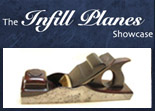Anderson Planes – Traditional Style Infill Planes
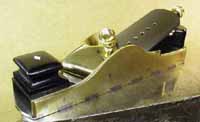 Anderson Planes is a one-man operation run by Wayne Anderson from a modest basement workshop in Elk River, MN. Each and every plane that has come out of the workshop over the years has been crafted by hand at almost every step of the way. Thankfully for hand plane aficionados it shows that you don’t actually need to have a lot of workshop space to produce beautiful, world class, custom made hand planes of the highest caliber, which are desired by both tool collectors and woodworkers alike.
Anderson Planes is a one-man operation run by Wayne Anderson from a modest basement workshop in Elk River, MN. Each and every plane that has come out of the workshop over the years has been crafted by hand at almost every step of the way. Thankfully for hand plane aficionados it shows that you don’t actually need to have a lot of workshop space to produce beautiful, world class, custom made hand planes of the highest caliber, which are desired by both tool collectors and woodworkers alike.
Each plane is skillfully designed and built using old world methods. Bodies of bronze, brass, or steel, are carefully hand dovetailed to a steel sole, and then the shell fitted with exotic woods. The free-flowing curves and sweeps of the sculpted metal sides and exotic wooden infills almost belie the fact that there are some very solid and sound hand plane mechanics at play here. The designs come from a range of sources, from the infill plane standards set by Norris, Spiers and Mathieson right down to nature-inspired replicas of 16th and 17th century “user built” planes found in museums and collections from around the world. Chariot planes who’s designs are derived from scarab beetles and acanthus leaves abound in Wayne’s workshop.
However these planes are more than copies of the tools of the well known, and lesser known, makers of the past. They are very much unique examples of the art and craftsmanship of fine hand tools. Each hand plane is carefully designed and created – one at a time – to be a tool that is not only a pleasure to hold, but also possesses a fine degree of functionality. In short they are a joy to use, and it is this “investment in quality” which sees Wayne Anderson’s planes grace the shops of collectors and users alike. Its no secret that for three years in a row Fine Woodworking magazine has chosen pictures of Wayne’s planes to appear in their annual issue of Tools & Shops and, quite recently, Wayne was featured making his planes for a segment of the PBS show Venture North.
It was a natural and logical step for Anderson to become a premiere planemaker. He always showed artistic tendencies as a child and later on chose a career path as a machinist in a metal fabricating workshop culminating into now working part-time as a mechanical designer. This background allows Wayne to be both knowledgeable in machine tools and computers as well as their hand tool predecessors. By day he might be concentrating on designing weapon systems for the army using high-powered computers but, in his spare time, out comes the hacksaw, files, steel, bronze and rosewood and its planemaking which takes over.
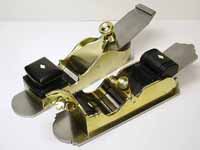 Along with building hand planes, Wayne has been an avid collector of vintage tools for quite some time. His interest in hand tools and planemaking began several years ago when he and a friend would haunt the local woodworking supply stores. In one of those stores there was a poster of the famous H.O Studley tool chest, which was featured in Fine Woodworking magazine. For those who are unaware of the Studley chest it is a small, wall-hung chest which manages to squeeze some 300 or so hand tools within its multi-layered design and is truly a work of art in itself. Wayne was immediately drawn to the beauty and complexity of the chest and decided to “amass a collection of vintage tools”.
Along with building hand planes, Wayne has been an avid collector of vintage tools for quite some time. His interest in hand tools and planemaking began several years ago when he and a friend would haunt the local woodworking supply stores. In one of those stores there was a poster of the famous H.O Studley tool chest, which was featured in Fine Woodworking magazine. For those who are unaware of the Studley chest it is a small, wall-hung chest which manages to squeeze some 300 or so hand tools within its multi-layered design and is truly a work of art in itself. Wayne was immediately drawn to the beauty and complexity of the chest and decided to “amass a collection of vintage tools”.
As he found himself getting deeper and deeper into collecting, Anderson stumbled on a story about British infill plane maker Bill Carter and was so taken by it that he decided to make an improved miter plane for himself, which he still owns. Anderson describes this plane as “butt ugly” but adds that it functions well. With 3/16″ thick sides and 1/4″ thick sole its “like your kid’s artwork. It’s not worth a nickel, but you wouldn’t sell it for a million bucks.”
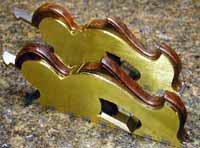 Encouraged by the result, Anderson began to make more planes which he would then post pictures of on the internet to show other like-minded enthusiasts. This resulted in generating a lot of interest in Wayne’s planes and before too long people were lining up and asking to buy them. With this in mind Wayne continued to develop his skills as a planemaker and has recently shifted into high gear by going part-time in his day job so that he can concentrate on making more planes. He’s also purchased a few machines to help out with the more “menial” tasks of cutting, drilling and milling – though by far the bulk of the work is still done by hand just as it was when he first started. A drill press helps out with drilling accurate holes through the plane bodies and lever caps and a small bandsaw cuts out the blanks for the wooden infills. A small, recently acquired, milling machine assists in cutting the mouths in the soles.
Encouraged by the result, Anderson began to make more planes which he would then post pictures of on the internet to show other like-minded enthusiasts. This resulted in generating a lot of interest in Wayne’s planes and before too long people were lining up and asking to buy them. With this in mind Wayne continued to develop his skills as a planemaker and has recently shifted into high gear by going part-time in his day job so that he can concentrate on making more planes. He’s also purchased a few machines to help out with the more “menial” tasks of cutting, drilling and milling – though by far the bulk of the work is still done by hand just as it was when he first started. A drill press helps out with drilling accurate holes through the plane bodies and lever caps and a small bandsaw cuts out the blanks for the wooden infills. A small, recently acquired, milling machine assists in cutting the mouths in the soles.
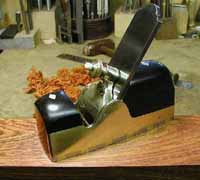 Unlike most of the “new crop” of planemakers that has sprung up in recent years, Andersons planes don’t generally follow the styles made popular by Stewart Spiers and co. “They’re the production planes of the era and I was never impressed with the style”, says Wayne. Moreso collectors are drawn to the fact that Wayne’s hand planes are a little “out of the ordinary” and set apart from the other dovetailed metal planemakers. In this regard the planes are more reminiscent of fine furniture and archetectual designs than your normal run-of-the-mill woodworking tools. Of course this means that the planes are a little more expensive than many of the Spiers and Norris planes, but at approximately $150-$200 per inch for Anderson’s planes they are competitively priced amongst contemporary infill plane makers. Wayne isn’t driven by money though, and prices his tools so he can continue to “stay busy” and make the kinds of tools he wants to, whenever he wants to.
Unlike most of the “new crop” of planemakers that has sprung up in recent years, Andersons planes don’t generally follow the styles made popular by Stewart Spiers and co. “They’re the production planes of the era and I was never impressed with the style”, says Wayne. Moreso collectors are drawn to the fact that Wayne’s hand planes are a little “out of the ordinary” and set apart from the other dovetailed metal planemakers. In this regard the planes are more reminiscent of fine furniture and archetectual designs than your normal run-of-the-mill woodworking tools. Of course this means that the planes are a little more expensive than many of the Spiers and Norris planes, but at approximately $150-$200 per inch for Anderson’s planes they are competitively priced amongst contemporary infill plane makers. Wayne isn’t driven by money though, and prices his tools so he can continue to “stay busy” and make the kinds of tools he wants to, whenever he wants to.
To check out the Anderson Planes website, click here.






